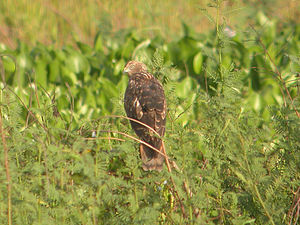Candaba river marshes
| Candaba river marshes | ||
|---|---|---|
| Philippine Duck | ||
|
|
||
| Location: | Philippines | |
| Specialty: | Luzon | |
| Next city: | Pampanga provinces , Bulacan | |
| Surface: | 5.00 km² | |
| Peregrine Whistle Goose | ||
The Candaba River Marshes ( en: Candaba Swamp ) are a river marshland on the island of Luzon , Philippines . The river marshes extend over 32,000 hectares in the provinces of Pampanga and Bulacan . They are among the largest marshlands in the Philippines and are flooded in the rainy season by the Maasim, San Miguel, Garlang, Bulu and Penaranda rivers. These arise in the Sierra Madre and are tributaries of the Pampanga , which flows nine kilometers northwest of Baliuag in the region. The river marshes are on the territory of the Candaba communities, San Miguel and San Ildefonso , about 50 kilometers northwest of Manila .
The wetland consists of a complex of rivers, islands, small freshwater lakes, ponds and marshland, which is surrounded by a spacious grass savannah landscape. The grass savannahs are interspersed with extensive palm groves. In the rainy season, this type of vegetation is flooded over a large area and the resulting lakes are partially used as natural aquaculture , for example to breed milk fish ( Chanos chanos ). When the areas begin to dry out, they are used as rice fields in order to allow the grass savannahs to emerge again in the dry season. The average water depth is one to two meters in the dry season and swells up to 5 meters in the rainy season.
In the Candaba river marshes there are large alluvial areas with an approximate size of 300 hectares, which serve as a habitat for the Philippine duck ( Anas luzonica ), the teal duck ( Anas querquedula ) and the pintail ( Anas acuta ) at any time of the year . The average bird population is 5,000 to 10,000 animals. In 1982 up to 100,000 ducks could be counted in the rainy season. From migratory birds such as the great egret ( Egretta alba ), 3,000 to 5,000 animals were observed in 1987. Other rare migratory birds are the millet warbler ( Acrocephalus sorghophilus ) breeding in northern China and the peregrine whistle ( Dendrocygna arcuata ). Observations are known of the rare mangrove harrier ( Circus spilonotus ), the water tap ( Gallicrex cinerea ) and of coastal birds such as seagulls . The Candaba River Marsh serves as a breeding area for around 60 species of birds . 500 hectares of the Candaba river marshes have been designated as bird sanctuaries .
The region's climate is divided into two seasons, with a rainy season from November to May and a dry season from June to October.
See also
Other swamp, wet and marshland landscapes in the Philippines




